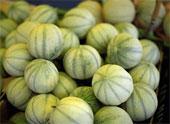Melons are the most important fruit in Brazil in 2009
Brazil
Wednesday 09 December 2009
Melons are grown on an area of some 13,000 ha
According to the Brazilian Seed and Seedling Trade Association (ABCSEM), Brazilian fruit and vegetable production covers an area of some 700,000 hectares. Open field cultivation predominates, and harvests are almost entirely destined for domestic consumption. The only crop that is exported is the melon.
The most important fruit and vegetables are watermelons (63,000 ha), tomatoes (53,000 ha) and onions (50,000 ha).
In terms of value generated in the supply chain, again watermelons, tomatoes and onions lead the way, and it is these products in which the highest level of technological investment has been made.
The most important fruit and vegetables are watermelons (63,000 ha), tomatoes (53,000 ha) and onions (50,000 ha).
In terms of value generated in the supply chain, again watermelons, tomatoes and onions lead the way, and it is these products in which the highest level of technological investment has been made.
- Brazilian growers demonstrate a keen business acumen;
- Climatic conditions in the different regions of the country offer year-round production;
- Professional growers have developed a good infrastructure.
Therefore, Brazil could become a key vegetable exporter in the future, particularly for tomatoes, sweetcorn and onions.
Melons are grown on an area of some 13,000 hectares. At present, they are mainly exported to Europe and a wide range of varieties is offered.
According to SECEX / IBRAF (Brazilian Foreign Trade Secretariat / Brazilian Fruit Institute), in 2008 Brazil exported nearly 212 million kg of melons worth US$152 million.





